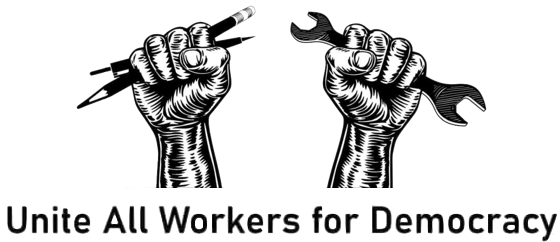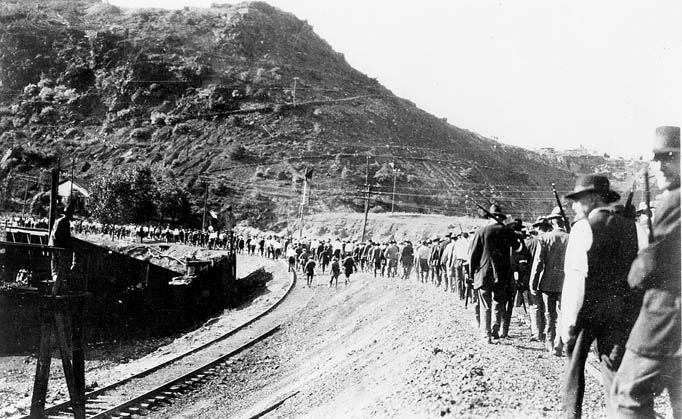Mine owners in Bisbee, Arizona round up Wobblies, Mexicans, and anyone they found suspicious and drop them into the New Mexico desert. Let’s talk about the Bisbee Deportation and the huge violations of workers’ rights in World War I.
The summer of 1917 was tense in the United States. The entrance of the nation into World War I that spring seemed to place the entire nation on edge.
Progressivism, a diverse movement with widely mixed motivations among its members, showed its dark side like never before, using the increasingly activist federal government to suppress all perceived threats to middle-class, patriotic America.
The Woodrow Wilson Administration cracked down on dissent, passing the Espionage Act in June, a law used — along with several other laws passed during the war — to crack down on any criticism of the war.
Anti-immigrant movements increased their activities–after nearly 40 years of intense immigration, Americans’ feared more than ever immigrants’ impact upon the nation.
The prohibition movement also took advantage of the war, using the connection between immigrants and alcohol to push through the 18th Amendment. Vigilante attacks against labor organizers, particularly radical labor, increased.
To name one notorious incident, Industrial Workers of the World organizer Frank Little was lynched in the summer of 1917 in Butte, Montana and probably by Pinkertons.
Corporations were quick to see the opportunity wartime hysteria offered. Among them was Phelps-Dodge. One of the nation’s largest mining conglomerations, Phelps-Dodge operated on both sides of the U.S.-Mexican border, mining a number of minerals, but especially copper.
As the company moved on both sides of the border, so did workers. Phelps-Dodge operations in southern Arizona were staffed by native-born American, Mexican, and eastern European workers.
Bisbee, Arizona was one of the major operations. The copper companies completely controlled Bisbee. Mine safety was a major problem. Housing conditions were extremely poor for most workers.
Remembered miner Fred Watson: “It was a pretty tough town. The conditions in the mines were intolerable. Absolutely. They never mentioned anything the miners asked for. Their demands were never mentioned.”
In response to the terrible conditions in Bisbee and around the border mining belt, the Industrial Workers of the World organized the miners.
The IWW began in 1905 out of the Western Federation of Miners, which had represented workers in a number of brutal mining strikes in the previous years.
Building off those experiences, the IWW took their message of a world controlled by workers, a world without rapacious capitalists brutalizing workers to the nation and the world.
The IWW was particularly successful with the itinerant and desperate laborers of the Northwest–miners, loggers, and agricultural workers.
The American Federation of Labor was also active in Bisbee.
In 1916, the AFL-affiliated International Union of Mine, Mill, and Smelter Workers had about 1,800 mostly native-born American members in Bisbee. The IWW organized the most marginalized workers: Mexicans and eastern European immigrants.
As it did with its actions throughout the nation, the IWW took a flexible approach to its organizing, subsuming its larger ideological desire for worker control over the means of production to whatever local workers needed.
Interestingly, Mine Mill and its president Charles Moyer did little to encourage the new unionization efforts in Bisbee, which opened the door for the IWW to walk on in. By June 1917, the IWW claimed about 1,000 members, although only about 400 were dues-paying.
On June 24, 1917, the IWW in Bisbee presented the copper companies with a list of demands. Among them were better living and working conditions, more men per machine, an end to blasting while men were in the mine, a $6 per day wage instead of the current sliding scale, and nondiscrimination against union workers. Phelps-Dodge refused to negotiate.
By June 27, about 50% of Bisbee miners were on strike and that number soon rose to 85%, as workers from other companies joined the strike, making the same demands on their own employers.
Phelps-Dodge and the smaller operations in Bisbee decided to use the war as a pretext to crack down on the Wobblies once and for all. Newspapers in Bisbee and around the nation accused the IWW of pro-German sympathy. This was absurd, though the Wobblies did oppose the war.
Local elites created the Citizens’ Protective League under control of the sheriff, but really under the control of Phelps-Dodge president James Douglas, who had vowed to return the mines to the open shop. And it decided to round up the Wobblies and ship them out, per Douglas’s orders on July 5.
On July 11, 1917, the Citizens Protective League put out a call to the surrounding areas for deputies. 2,000 men assembled by the next morning. They took over the Western Union office to prevent word getting out about their actions.
They then went around to the miners’ cabins and rounded people suspected of radicalism or of being Mexican or eastern European. They collected 1,186 men many of whom were not on strike or even miners. They then went around to the miners’ cabins and rounded people suspected of radicalism or of being Mexican or eastern European. They collected 1,186 men many of whom were not on strike or even miners.
By this time, people heard about what was happening, largely because the vigilantes wanted to drop them in Columbus, New Mexico (a town already famous for being burned by Pancho Villa), but Columbus wouldn’t take them.
A train did give them some food and water, but the 1186 men were abandoned out there for 2 days, when finally the U.S. military collected them and placed them in pens near Columbus that were originally built to provide minimal shelter for people fleeing Villa in northern Mexico.
Nothing really happened to the copper companies for this action. The Wilson Administration ordered a cursory investigation, but clearly did not care a great deal given its lack of respect for civil liberties of radicals.
The Federal Mediation Commission did say that the copper companies were at fault, but said that the state of Arizona should deal with it.
Not surprisingly, Arizona did nothing.
Meanwhile, the Citizens Protective League ruled Bisbee as a paramilitary force, interrogating residents on their politics, restricting entrance into the town and the mines, and creating kangaroo courts to evict strangers to town under the threat of lynching if they returned.
When the sheriff was rebuked by the Arizona attorney general, he fully admitted what he was doing was illegal, but said, “It became a question of ‘Are you American, or are you not?’” Such is the usual defense of the fascist.
Although it became a cause celebre among unions throughout the nation, the Bisbee Deportation crushed the miners union. Of course, those rounded up had done nothing wrong. Most were soon released by the army to go back to mining or to slip back to Mexico.
Meanwhile, Americans seeking to crack down on dissent, such as Attorney General A. Mitchell Palmer, used the threat of radical unions in Bisbee as a justification to argue for the extension of the Espionage Act into peacetime.
In 1985, an oral history with the grandson of the Phelps-Dodge founder took place. He laughed openly about the Bisbee Deportation. He thought it was hilarious.
http://www.library.arizona.edu/exhibits/bisbee/docs/rec_doug.html
Survivor and miner Fred Watson remembered it somewhat differently, as the tragedy it was.
http://www.library.arizona.edu/exhibits/bisbee/docs/jahwats.html
Sadly, this would be far from the last time vigilantes took advantage of World War I hysteria and the Red Scare to intimidate unions, deport radicals, and murder union members.

